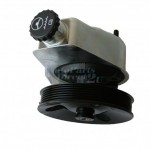The power steering system in your car is made up of a power steering rack, pump, hose, lines, reservoir and steering column, some of these components may need  to be replaced at some point. If you feel it is getting harder to steer or turn your steering wheel you should check your power steering system for low fluid, leaks or parts that might need to be replaced. Checking your power steering system when you first notice the steering to be harder can prevent a major component needing replacement. If your car wander’s from side to side as you drive, even when keeping the steering wheel straight you may have worn or loose steering components.
to be replaced at some point. If you feel it is getting harder to steer or turn your steering wheel you should check your power steering system for low fluid, leaks or parts that might need to be replaced. Checking your power steering system when you first notice the steering to be harder can prevent a major component needing replacement. If your car wander’s from side to side as you drive, even when keeping the steering wheel straight you may have worn or loose steering components.
Take the following steps:
- If your car is hard to steer you should check the power steering fluid. A low amount of power steering fluid will make it hard to turn the steering wheel. This also means that the power steering components are not getting enough or any fluid and the components may need to be replaced.
- After checking the power steering fluid if it is still hard to turn the steering wheel you should check the power steering pump and belt. Have the bonnet open and start your car. While someone is turning the steering wheel, you can listen to the power steering pump. If you hear a whine or loud noise the power steering belt might be slipping. Check the belt and adjust if needed. Turn the steering wheel all the way to the left, than to the right several times.
- Check the power steering pump, hoses and lines around the power steering rack and see if there are any leaks, use a torch if you need to. If you keep topping up the power steering fluid you may have a leak. Wipe all components and hoses with a rag and recheck a couple of days later.
- If the steering is still hard, check the steering column, arms at both ends of the power steering rack and brackets to see if they are loose or worn.
If you find or suspect loose or worn parts, contact your local mechanic to diagnose which part needs to be replaced.
If you have checked and are unsure, take your car to your local mechanic to diagnose and fix the problem.


